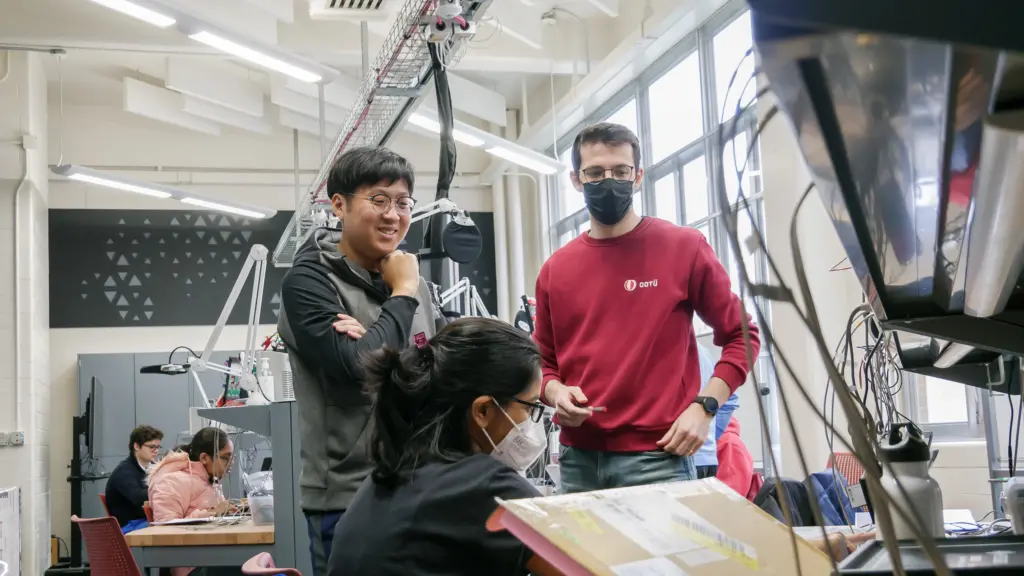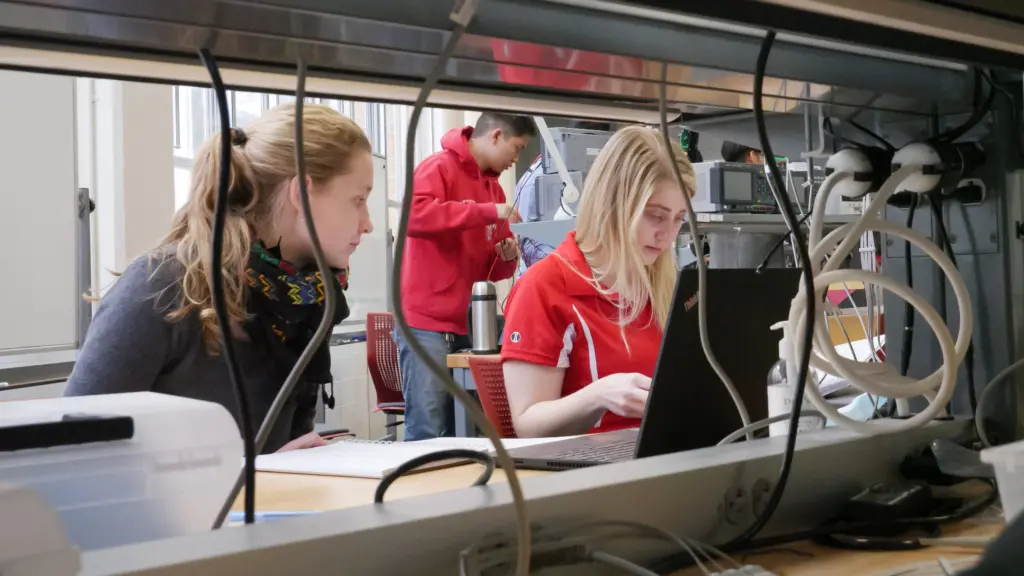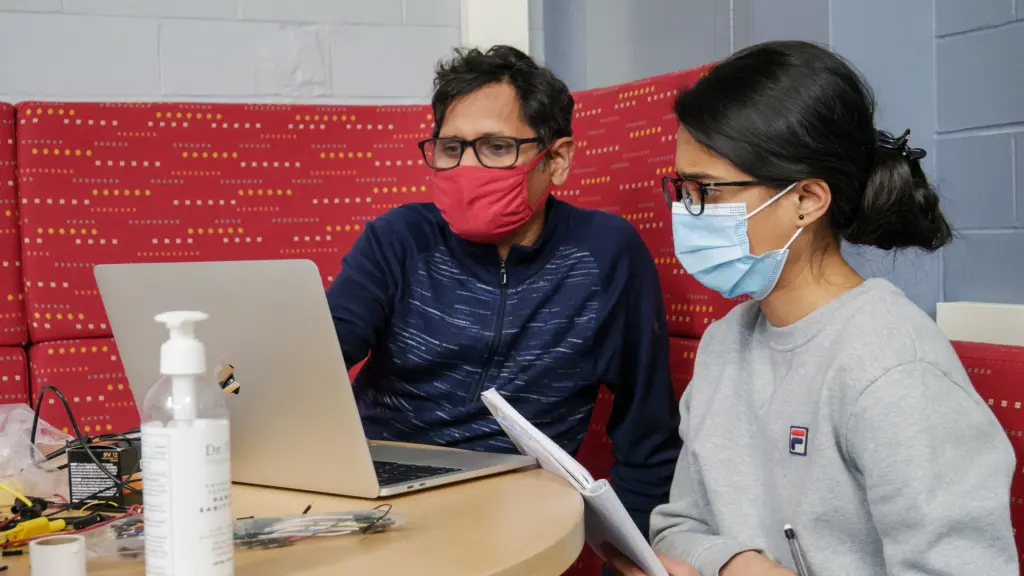A sharper focus on the scholarly side of learning benefits not only students, but the discipline as a whole.
“In research, taking risks is rewarded, because it may lead to breakthroughs,” says Civil and Environmental Engineering Associate Professor Andrea Hicks. “Teaching needs to be viewed through the same lens in order to produce the engineers we need for the future.”
Bringing people, passion, knowledge, resources and research together in a singular effort, our new Center for Innovation in Engineering Education provides the opportunity for our faculty and staff to approach engineering education just as boldly.
A gift from Keith Nosbusch (BSEE ’74) and his wife, Jane, supports part of the center, which aims to advance learning for all and to equip engineers to positively impact the world.
Not just another Zoom

“When you think of innovation, you often think of technology,” says David Noyce, college executive associate dean. “This isn’t necessarily loading classrooms with technology. We’re trying to do things in a better way.”
The landscape of education innovation is, in fact, expansive. Over time, it is transformative. The discipline itself is grounded in scholarly research, which then informs everything that follows: Aligning teaching methods and approaches with how diverse students learn and retain information best. Ensuring that our faculty, instructors and teaching assistants have the knowledge and support to implement best practices in their courses. Revisiting and revising our curriculum frequently to ensure our content remains relevant. Creating spaces that facilitate learning for all. Developing our students’ confidence in their ability to succeed as engineers and offering supplemental instruction and advising when and how they need it. Teaching not only technical skills, but also how to communicate effectively, work successfully in teams, lead inclusively, and work ethically. Understanding the broader context in which engineers can appropriately and beneficially apply their skills. Enhancing the links between theory and real-world contemporary societal challenges relevant to our students’ lives. Connecting students with community members.
Hicks is among several engineering faculty who are testing potentially transformative educational practices. For several years, she has worked with the UniverCITY Year program at UW-Madison to teach her Environmental Sustainability Engineering course. Her students work on a semester-long team project in partnership with community members who have identified a challenge they need help solving.
“As a professor, I have the unique opportunity to shape how a student thinks about an idea or concept,” says Hicks. “It is my firm belief that I am helping to create my future colleagues.”
Hicks also disseminates best practices in sustainability education for engineers via published peer-reviewed research papers. She, and Electrical and Computer Engineering Professors John Booske and Giri Venkataramanan hold Keith and Jane Morgan Nosbusch professorships, created to support faculty passionate about advancing the theory and practice of engineering education.

“I want to inspire the students in my courses to change the world and make it a better place through engineering,” says Hicks. “In creating future engineers, we need to align how students are evaluated with the actual engineering jobs they could have. This moves away from the idea of rote memorization to applying the skills and concepts they have learned in a meaningful manner.”
A growth model
Teaching and learning scholar and advocate Chris Dakes became the Center for Innovation in Engineering Education’s inaugural director in spring 2022. He joined a college brimming with faculty and instructors who, like Hicks, are passionate about doing everything they can to ensure their students’ success. The center will grow efforts in three initial areas of focus: teaching and learning scholarship, faculty development and instructional support, and student leadership education.
Center resources will support and advance educational research and broadly share findings to inform teaching and learning decisions right here in our college and beyond campus. Through the college’s Collaborative for Engineering Education and Teaching Effectiveness, led by director Erica Hagen, the center will enable a growing number of faculty and instructional staff to create effective learning environments in which all students can succeed. And Angela Kita, hired under the center as director of leadership education, will head work to advance student leadership education through in-class and beyond-the-classroom experiences—among them, our National Academy of Engineering Grand Challenges Scholars Program.

That’s just to start. “We’re all looking for ways to continuously improve and build on the strong foundations that already exist,” says Dakes. “We’re starting by connecting the dots of the existing areas of progress and innovation and building the supporting infrastructure necessary to sustainably propel us into the future.”
And of course, education innovation begins and ends with preparing people who are the future of our field. “We need to keep making sure our engineering students are at the forefront,” says Grainger Dean Ian Robertson. “At the end of the day, do employers keep coming back here and saying, ‘This is where we get really outstanding engineers’? That, to me, is what makes us successful.”
A tradition of education innovation
Announce that you’ve founded a center focused on innovation in engineering education, and that declaration might beg the question, “What were you doing before?”
In the case of the College of Engineering, that answer is “lots.”
“Seeking to improve the way that we’re innovative in how we educate students doesn’t mean we’re bad at it currently,” says Grainger Dean Ian Robertson. “We’re actually pretty good at it. And part of our contribution to engineering education is helping develop its future.”
In tandem with groundbreaking research, our engineers have been pioneers in advancing engineering education over the course of the college’s history.

Looking back several decades, for example, are Bird, Stewart and Lightfoot; in 1960, the internationally renowned trio of chemical engineering professors published the landmark textbook Transport Phenomena. Their approach fundamentally changed the organizing principle in chemical engineering curricula at UW-Madison and around the world.
Five years before YouTube’s debut (2005) as a video-sharing platform, now-emeritus Engineering Physics Professor Greg Moses and colleagues engaged in a revolutionary redesign of the traditional lecture mode. Their eTEACH software enabled instructors to record and create multimedia lectures. Students watched these videos on their own time; in class, they worked together to solve problems based on each lecture, while the instructor circulated, answered questions and clarified concepts. Today, this approach is ubiquitously known as blended learning.
In 2012, the first of many facilities devoted to active learning debuted at UW-Madison in College Library and in Wendt Commons. Together known as the Wisconsin Collaboratory for Enhanced Learning Center, or WisCEL, the flexible technology-rich spaces bring students together to solve problems in class and facilitate lively small-group discussion, peer-to-peer learning, and tutoring. John Booske, a professor of electrical and computer engineering and a Keith and Jane Morgan Nosbusch professor, spearheaded the creation of this learning environment.
Formed in fall 2015 with three mentors and 15 students, Informatics Skunkworks today engages approximately 100 undergraduates from four institutions in applied research at the intersection of data science and materials science. “The program seeks to provide authentic research, engaged personal learning and professional development while also being efficient, accessible and scalable,” notes its founder, Spangler Professor in materials science and engineering Dane Morgan in the abstract of a paper he and colleagues presented at the American Society for Engineering Education 2022 Annual Conference and Exposition.
Today, Alain H. Peyrot Assistant Professor in structural engineering Hannah Blum blends augmented and virtual reality to help her structural engineering students visualize everything from fractures in bolted steel connections to entire construction sites.
There are countless other examples woven throughout the college’s past and present.
Featured image caption: Keith and Jane Morgan Nosbusch Professor Giri Venkataramanan teaches the hands-on power electronics lab course for undergraduates and graduate students. One of three Nosbusch professors studying the practice of engineering education, Venkataramanan is piloting high-impact hands-on learning opportunities, developing facilities for scaling up high-impact learning practices, and exploring the effectiveness of self-directed learning. Credit: Joel Hallberg.